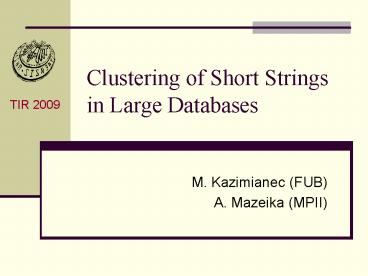Clustering of Short Strings in Large Databases - PowerPoint PPT Presentation
1 / 22
Title:
Clustering of Short Strings in Large Databases
Description:
Each string is represented as a set (bag) of unordered q-grams; ... countenance. 1. 15. 14. 13. 12. 11. 10. 9. 8. 7. 6. 5. 4. 3. 2. 1. s-border. q-length. String ... – PowerPoint PPT presentation
Number of Views:23
Avg rating:3.0/5.0
Title: Clustering of Short Strings in Large Databases
1
Clustering of Short Strings in Large Databases
- M. Kazimianec (FUB)
- A. Mazeika (MPII)
2
Outline
- Background (String Similarity, Proximity Graph
(PG), GPC Method) - Problem of Clustering Short Strings
- CLOSS. Milestones
- Border Identification
- Center Optimization
- PG Smoothing
3
String Similarity
- Each string is represented as a set (bag) of
unordered q-grams - One string is chosen as a counting point (center
c) - Overlap O of the string s with the center c is
computed - Overlap O is accepted as a string similarity
measure.
strip is more similar to string than triad.
4
Proximity Graph
- Proximity graph (PG) is a discrete numerical
decreasing function depending on overlap
threshold expressed by the integer value i. - In the point i PG value is a number of strings
that have overlap O with the center c not
exceeding the given threshold i.
5
GPC Method for String Clustering
- GPC takes a center string and examines the shape
of the proximity graph. If there is a horizontal
line (overlaps 3,4,5) then GPC declares the
cluster border in the extreme right point of the
line (border 5, cluster malcolm, malcom,
makolm).
6
What Are the GPC Disadvantages?
- GPC is weak if
- horizontal line is not present in the PG (short
strings), - there are multiple horizontal lines in the PG
(long and middle strings), - dataset is not ordered by string length.
GPC application is cut down by following PG
model
7
Problems of Clustering Short Strings
- Touching Clusters PG has no horizontal lines,
- Overlapping Clusters PG has multiple horizontal
lines.
8
Border IdentificationOxford Dataset Sample
Overlap value
Blue color marks out subjective (true) clusters.
Red color shows alien strings for s-border. The
last is minimal overlap preserving all
misspellings.
9
How we solve
The task is to minimize the number of alien
strings in the cluster maximally preserving
misspellings. The solution is related to the
CLOSS method (Clustering of Short Strings)
- Center optimization (by string ordering)
- Border identification
- Resolving of multiple PG lines
10
CLOSS. Dataset Ordering
- The choice of the shorter center may lead to a PG
shape without horizontal line even for long
strings
Center is malcolm
Center is malcom
Ordering by string length and clustering starting
from the longest strings resolve this problem.
11
CLOSS. Border Interval
- Border interval is found by means of PG
interpolation by the polynomial f(x).
Starting point is set to the overlap value,
where the curvature of f(x) is maximal
Ending point is set to be numbers of
q-grams away from the maximal overlap
12
CLOSS. Border Point
- Defined border exists independently of the PG
shape.
13
Algorithm
14
Evaluation. Clustering of the Cyclone Name
Dataset
- CLOSS and GPC (improved by string ordering) were
compared by applying them to the cyclone name
dataset (www.nhc.noaa.gov/aboutnames.html)
artificially corrupted by introducing
one mistake
many (up to 3) mistakes
15
Evaluation. Text Retrieval Using Oxford
Misspellings
- CLOSS was used to enhance text retrieval by means
of misspellings. File birkbeck
(http//ota.ahds.ac.uk/), containing 36133
misspellings of 6136 words, was considered as a
misspelling source.
PG Shapes
16
CLOSS and Subjective Clustering
17
CLOSS and Subjective Clustering
Preserving misspellings CLOSS reduces the number
of alien strings.
18
Multiple Horizontal Lines Problem
- Typical example is the DBLP dataset of paper
titles.
Multiple horizontal lines arise because of the
common words (and their parts) in the titles.
19
CLOSS. Smoothing
- Smoothing modifies the PG shape by using moving
averages. This allows to identify cluster border
for the case of multiple lines that take place in
datasets containing long and short/long strings.
PG without smoothing
Smoothed PG
20
Resume
- Proposed method is intended to cluster strings in
textual databases of different origin. It uses
dataset ordering, string representation by
q-grams, novel border identification technique as
well as proximity graph smoothing (for the case
of multiple horizontal lines). - Evaluation shows CLOSS efficiency for datasets
with strings of different length, even if cluster
border is not prominent (short strings).
21
Future Investigations
- It is observed that if PG has multiple horizontal
lines then clustering quality varies depending on
string length and smoothing interval. In the
nearest future we suppose to stabilize the
quality applying adaptive smoothing that takes
into account string length dispersion in each
point of the proximity graph.
22
Questions
?































